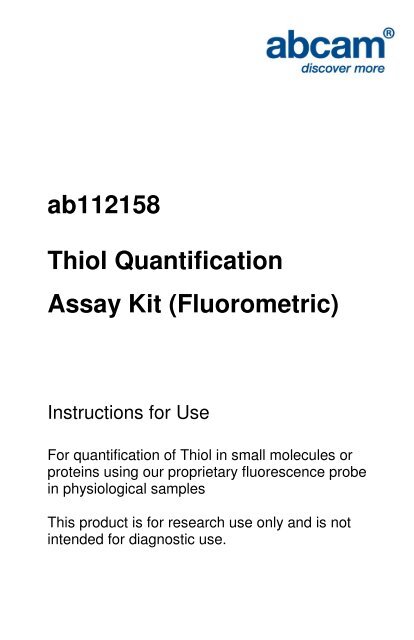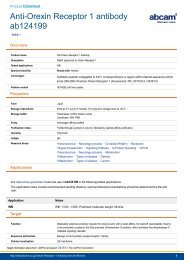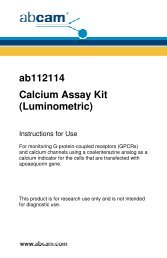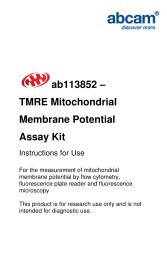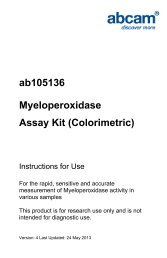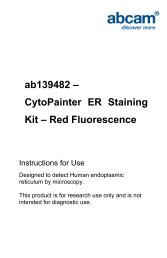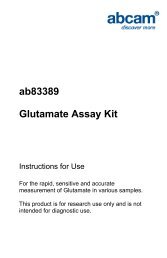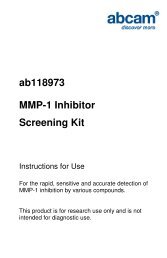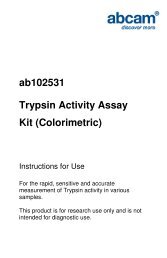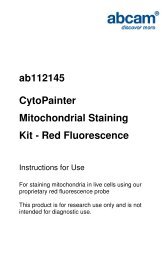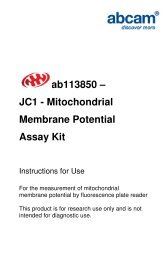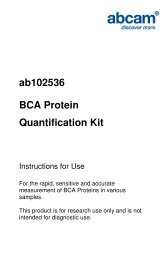ab112158 Thiol Quantification Assay Kit (Fluorometric) - Abcam
ab112158 Thiol Quantification Assay Kit (Fluorometric) - Abcam
ab112158 Thiol Quantification Assay Kit (Fluorometric) - Abcam
- No tags were found...
You also want an ePaper? Increase the reach of your titles
YUMPU automatically turns print PDFs into web optimized ePapers that Google loves.
<strong>ab112158</strong><strong>Thiol</strong> <strong>Quantification</strong><strong>Assay</strong> <strong>Kit</strong> (<strong>Fluorometric</strong>)Instructions for UseFor quantification of <strong>Thiol</strong> in small molecules orproteins using our proprietary fluorescence probein physiological samplesThis product is for research use only and is notintended for diagnostic use.
Table of Contents1. Introduction 32. Protocol Summary 53. <strong>Kit</strong> Contents 64. Storage and Handling 65. <strong>Assay</strong> Protocol 76. Data Analysis 117. Troubleshooting 122
<strong>Kit</strong> Key Features• Broad Application: Can be used for quantifying thiol andsulfide in a variety of biological systems (e.g., plasma, urineand cell extracts)• Sensitive: Detect as low as 1 picomole of thiol.• Continuous: Easily adapted to automation without aseparation step.• Convenient: Formulated to have minimal hands-on time. Nowash is required.• Non-Radioactive: No special requirements for wastetreatment.4
2. Protocol SummarySummary for One 96-well PlatePrepare assay reaction mixture (50 µL)Add GSH standards or test samples (50 µL)Incubate at room temperature for 10-60 minutesMonitor the fluorescence intensity atEx/Em = 490/520 nmNote: Thaw all the kit components to room temperature beforestarting the experiment.5
3. <strong>Kit</strong> ContentsComponentsAmountComponent A: Green Indicator (light sensitive)1 vialComponent B: <strong>Assay</strong> Buffer25 mLComponent C: GSH Standard 62 µgComponent B: DMSO 100 µL4. Storage and HandlingKeep at -20°C. Avoid exposure to moisture and light.6
5. <strong>Assay</strong> ProtocolNote: This protocol is for one 96 - well plate.A. Preparation of GSH Standard Stock SolutionsAdd 200 µL of ddH 2 O into the GSH standard vial(Component C) to make 1 mM (1 nmol/µL) stock solution.Note: The unused GSH solution should be divided intosingle use aliquots and stored at -20 °C.B. Preparation of 400X Green Indicator Stock SolutionAdd 25 µL of DMSO (Component D) into the vial of GreenIndicator (Component A) to make 400X stock solution.Note: The unused Green Indicator solution should be dividedinto single use aliquots, stored at -20 °C and kept from light.C. Preparation of GSH Reaction MixtureAdd 12.5 µL of 400X Green Indicator stock solution (fromStep B) into 5 mL of assay buffer (Component B), and mixwell.7
D. Preparation of serial dilutions of GSH standard (0 to30 µM)1. Add 30 µL of GSH standard stock solution (from Step A)to 970 µL of assay buffer (Component B) to generate30 µM (30 pmol/µL) GSH standard.Note: Diluted GSH standard solution is unstable. Usewithin 4 hours.2. Take 200 µL of 30 µM GSH standard solution to perform1:3 serial dilutions to get 10, 3, 1, 0.3, 0.1, 0.03, 0.01and 0 µM serial dilutions of GSH standard.3. Add GSH standards and GSH-containing or other thiolcontainingtest samples into a solid black 96-wellmicroplate as shown in Tables 1 and 2.Note: Treat cells or tissue samples as desired.8
BL BL TS TS .....GS1 GS1 .... ....GS2 GS2 .... ....GS3 GS3GS4 GS4GS5 GS5GS6 GS6GS7 GS7Table 1. Layout of GSH standards and test samples in asolid black 96-well microplate.Note: GS= GSH Standards, BL=Blank Control, TS=TestSamples.GSH Standard Blank Control Test SampleSerial dilutions*: 50 µL<strong>Assay</strong> Buffer:50 µL50 µLTable 2. Reagent composition for each well.*Note: Add the serially diluted GSH standards from 0.01µMto 10µM into wells from GS1 to GS7 in duplicate.9
E. Run GSH <strong>Assay</strong>:1. Add 50 µL of GSH reaction mixture (from Step C.1) toeach well of the GSH standard, blank control, and testsamples (see Step D.3) to make the total GSH assayvolume of 100 µL/well.Note: For a 384-well plate, add 25 µL of sample and25 µL of GSH reaction mixture into each well.2. Incubate the reaction at room temperature for10 minutes to 1 hour, protected from lightMonitor the fluorescence increase at Ex/Em = 490/520nm with a fluorescence plate reader.10
6. Data AnalysisThe fluorescence in blank wells (with assay buffer only) is used as acontrol, and is subtracted from the values for those wells with GSHreactions. A GSH standard curve is shown in Figure 1.Note: The fluorescence background increases with time, thus it isimportant to subtract the fluorescence intensity value of the blankwells for each data point.Figure 1. GSH and Cysteine dose responses were measured in a96-well black plate with <strong>ab112158</strong> using a microplate reader. As lowas 10 nM (1 pmol/well) of GSH or Cysteine can be detected with10 minutes incubation time (n=3).11
Figure 2 Shows the low levels of thiol detection possible.7. TroubleshootingProblem Reason Solution<strong>Assay</strong> notworking<strong>Assay</strong> buffer atwrong temperatureProtocol step missedPlate read atincorrect wavelengthUnsuitable microtiterplate for assay<strong>Assay</strong> buffer must not be chilled- needs to be at RTRe-read and follow the protocolexactlyEnsure you are usingappropriate reader and filtersettings (refer to datasheet)Fluorescence: Black plates(clear bottoms);Luminescence: White plates;Colorimetry: Clear plates.If critical, datasheet will indicatewhether to use flat- or U-shapedwells12
Problem Reason SolutionSampleswithinconsistentreadingsLower/Higherreadings insamplesandstandardsUnsuitable sampletypeSamples prepared inthe wrong bufferSamples notdeproteinized (ifindicated ondatasheet)Cell/ tissue samplesnot sufficientlyhomogenizedToo many freezethawcyclesSamples containimpeding substancesSamples are too oldor incorrectly storedNot fully thawed kitcomponentsOut-of-date kit orincorrectly storedreagentsReagents sitting forextended periods oniceIncorrect incubationtime/ temperatureIncorrect amountsusedRefer to datasheet for detailsabout incompatible samplesUse the assay buffer provided(or refer to datasheet forinstructions)Use the 10kDa spin column(ab93349) or Deproteinizingsample preparation kit(ab93299)Increase sonication time/number of strokes with theDounce homogenizerAliquot samples to reduce thenumber of freeze-thaw cyclesTroubleshoot and also considerdeproteinizing samplesUse freshly made samples andstore at recommendedtemperature until useWait for components to thawcompletely and gently mix prioruseAlways check expiry date andstore kit components asrecommended on the datasheetTry to prepare a fresh reactionmix prior to each useRefer to datasheet forrecommended incubation timeand/ or temperatureCheck pipette is calibratedcorrectly (always use smallestvolume pipette that can pipetteentire volume)13
UnexpectedresultsStandardcurve is notlinearMeasured at wrongwavelengthSamples containimpeding substancesUnsuitable sampletypeSample readings areoutside linear rangeNot fully thawed kitcomponentsPipetting errors whensetting up thestandard curveIncorrect pipettingwhen preparing thereaction mixAir bubbles in wellsConcentration ofstandard stockincorrectErrors in standardcurve calculationsUse of otherreagents than thoseprovided with the kitUse appropriate reader and filtersettings described in datasheetTroubleshoot and also considerdeproteinizing samplesUse recommended samplestypes as listed on the datasheetConcentrate/ dilute samples tobe in linear rangeWait for components to thawcompletely and gently mix prioruseTry not to pipette too smallvolumesAlways prepare a master mixAir bubbles will interfere withreadings; try to avoid producingair bubbles and always removebubbles prior to reading platesRecheck datasheet forrecommended concentrations ofstandard stocksRefer to datasheet and re-checkthe calculationsUse fresh components from thesame kitFor further technical questions please do not hesitate tocontact us by email (technical@abcam.com) or phone (select“contact us” on www.abcam.com for the phone number foryour region).14
UK, EU and ROWEmail: technical@abcam.comTel: +44 (0)1223 696000www.abcam.comUS, Canada and Latin AmericaEmail: us.technical@abcam.comTel: 888-77-ABCAM (22226)www.abcam.comChina and Asia PacificEmail: hk.technical@abcam.comTel: 108008523689 ( 中 國 聯 通 )www.abcam.cnJapanEmail: technical@abcam.co.jpTel: +81-(0)3-6231-0940www.abcam.co.jpCopyright © 2012 <strong>Abcam</strong>, All Rights Reserved. The <strong>Abcam</strong> logo is a registered trademark. 15All information / detail is correct at time of going to print.


